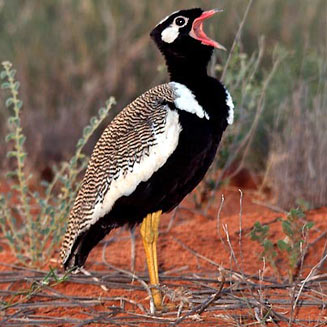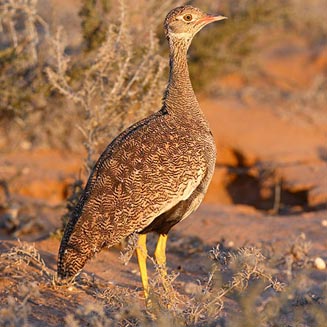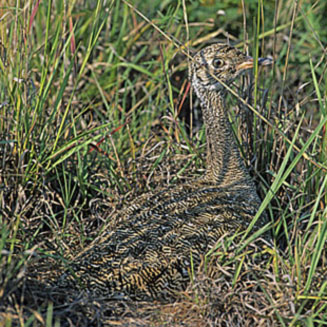|
Afrotis afraoides (Northern black
korhaan, White-quilled korhaan)
[= Eupodotis afraoides]
Witvlerkkorhaan [Afrikaans]; Botswana-trap [Dutch]; Outarde à miroir blanc [French]; Weißflügeltrappe [German]
Life
> Eukaryotes >
Opisthokonta
> Metazoa (animals) >
Bilateria >
Deuterostomia > Chordata >
Craniata > Vertebrata (vertebrates) > Gnathostomata (jawed
vertebrates) > Teleostomi (teleost fish) > Osteichthyes (bony fish) > Class:
Sarcopterygii (lobe-finned
fish) > Stegocephalia (terrestrial
vertebrates) > Tetrapoda
(four-legged vertebrates) > Reptiliomorpha > Amniota >
Reptilia (reptiles) >
Romeriida > Diapsida > Archosauromorpha > Archosauria >
Dinosauria
(dinosaurs) > Saurischia > Theropoda (bipedal predatory dinosaurs) >
Coelurosauria > Maniraptora > Aves
(birds) >
Order: Gruiformes
> Family: Otitidae
 |
 |
|
Northern black korhaan male. [photo
Callie de Wet ©] |
Nortern black korhaan female, Kgalagadi
Transfrontier National Park, South Africa. [photo
Lizet Grobbelaar ©] |
The Northern black korhaan is endemic to southern Africa, and
is uncommon to common in a wide variety of habitats. It feeds mainly on insects,
such as termites, grasshoppers and beetles, but it also eats plant products,
such as seeds. The male vigorously defends his displaying territory from other
males, attacking them with his wings and mating with multiple females, who
solely incubates the 1-3 eggs and raises the chicks. Amazingly, the chicks can
fly when they are only half grown!
Distribution and habitat
Endemic to southern Africa, it is common in Namibia, Botswana and
northern South Africa. It
occurs in nama karoo, kalahari sandveld, dry sandveld, open savanna and
grass-covered dunes. It generally prefers heavily grazed areas with sparse
ground cover.
Predators and parasites
Food
Feeds on a wide variety of
invertebrates and plant products, such as seeds. It forages by walking slowly,
pecking food items from the ground and chasing insects. The following food items
have been recorded in its diet:
- Plant matter
- seeds
- Themeda triandra (Red grass)
- Lycium (honey-thorns)
- Conyza bonariensis (Flax-leaf fleabane)
- Rhus lancea (Karee)
- Zea mays (Maize)
- Myrsine africana (Cape myrtle)
- Melilotus (sweet clover)
- fruit
Breeding
- Polygynous, territorial solitary nester.
Courtship is elaborate, involving multiple females and one male and featuring
exaggeratedly undulating flight displays, playful chasing and the male
displaying his white breast patches. The male is
extremely protective of his 200-300 m2 territory, fighting other
males by striking with his wings, after which the other male usually flies
off.
- It does not build a nest, laying its eggs directly on the ground among scattered grass tufts and shrubs, often under small thorn
trees.
 |
|
|
Northern black korhaan female incubating its eggs,
Sericea farm, South Africa. [photo Warwick Tarboton ©] |
|
- Egg-laying season is year-round, peaking from September-March.
- It lays 1-3, usually 1-2 eggs, which are incubated solely by the female
for 21-23 days (recorded in captivity).
- The female cares for the chicks, who can fly when they are
only half-grown.
Threats
Not threatened, although its population has decreased in
extensively cultivated areas. In 1980 a dealer was caught with at least 50
Northern black korhaans, that were about to be exported to the Middle east,
probably to be used for falconry.
References
-
Hockey PAR, Dean WRJ and Ryan PG (eds) 2005. Roberts
- Birds of southern Africa, VIIth ed. The Trustees of the John Voelcker
Bird Book Fund, Cape Town.
|
